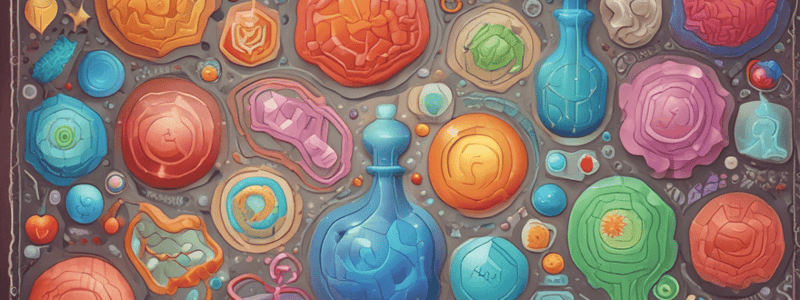Podcast
Questions and Answers
What is the purpose of adding 2-3 drops of iodoform reagent to each tube?
What is the purpose of adding 2-3 drops of iodoform reagent to each tube?
- To detect the presence of proteins
- To detect the presence of lipids
- To identify the presence of starch (correct)
- To detect the presence of reducing sugars
What is the result of a positive iodoform test?
What is the result of a positive iodoform test?
- A purple color
- A yellow color
- A red brick color
- A blue-black color (correct)
Which reagent is used to detect the presence of proteins?
Which reagent is used to detect the presence of proteins?
- Sudan 3
- Vibure reagent (correct)
- PeLienk reagent
- Fehling's reagent
What is the result of a positive Vibure test?
What is the result of a positive Vibure test?
Which reagents are used to detect the presence of reducing sugars?
Which reagents are used to detect the presence of reducing sugars?
What is the result of a positive Fehling and PeLienk test?
What is the result of a positive Fehling and PeLienk test?
Which reagent is used to detect the presence of lipids?
Which reagent is used to detect the presence of lipids?
What is the result of a positive Sudan 3 test?
What is the result of a positive Sudan 3 test?
Flashcards are hidden until you start studying
Study Notes
Biomolecules Identification
- Identifying biomolecules in 10 food samples using different reagents:
- Iodoform test for starch
- Vibri reagent for proteins
- Fehling and PeLienk reagents for reducing sugars
- Sudan 3 and vegetal dye for lipids
Starch Identification
- Iodoform test:
- Add 2-3 drops of iodoform reagent to each tube
- Shake the tubes well
- Observe color change:
- Positive result: blue-black color (starch present)
- Results:
- Tube 6 (potato): positive result
- Tube 7 (sausage): positive result
- Tube 8 (starch): positive result
- Tube 9 (milk powder): positive result
Protein Identification
- Vibure reagent:
- Add 5 drops of Vibure reagent to each tube
- Shake the tubes well
- Observe color change:
- Positive result: purple color (proteins present)
- Results:
- Tube 4 (egg white): strong positive result
- Tube 2 and Tube 7: weaker positive results
- Milk and milk powder: may contain proteins, but white color masks the purple color
Reducing Sugars Identification
- Fehling and PeLienk reagents:
- Add 5 drops of Fehling's reagent to each tube
- Add 5 drops of PeLienk reagent to each tube
- Observe color change:
- Positive result: red brick color (reducing sugars present)
- Results:
- Tube 3 (glucose): strong positive result
Lipid Identification
- Sudan 3 and vegetal dye:
- Add 1 mL of vegetal dye to each tube
- Add 3 drops of Sudan 3 to each tube
- Observe color separation:
- Positive result: Sudan 3 mixes with lipids, while vegetal dye stays at the bottom
- Results:
- Tube 10 (oil): Sudan 3 mixes with lipids, while vegetal dye stays at the bottom
Biomolecules Identification
- 4 types of biomolecules identified in 10 food samples using different reagents
- Reagents used: iodoform, Vibure, Fehling, PeLienk, Sudan 3, and vegetal dye
Starch Identification
- Iodoform test detects starch
- Procedure: add 2-3 drops of iodoform reagent, shake, and observe color change
- Positive result: blue-black color indicates starch presence
- Results: starch present in Tubes 6 (potato), 7 (sausage), 8 (starch), and 9 (milk powder)
Protein Identification
- Vibure reagent detects proteins
- Procedure: add 5 drops of Vibure reagent, shake, and observe color change
- Positive result: purple color indicates protein presence
- Results: strong positive result in Tube 4 (egg white), weaker positive results in Tubes 2 and 7
Reducing Sugars Identification
- Fehling and PeLienk reagents detect reducing sugars
- Procedure: add 5 drops of Fehling's reagent and 5 drops of PeLienk reagent, observe color change
- Positive result: red brick color indicates reducing sugar presence
- Results: strong positive result in Tube 3 (glucose)
Lipid Identification
- Sudan 3 and vegetal dye detect lipids
- Procedure: add 1 mL of vegetal dye and 3 drops of Sudan 3, observe color separation
- Positive result: Sudan 3 mixes with lipids, while vegetal dye stays at the bottom
- Results: positive result in Tube 10 (oil)
Studying That Suits You
Use AI to generate personalized quizzes and flashcards to suit your learning preferences.




